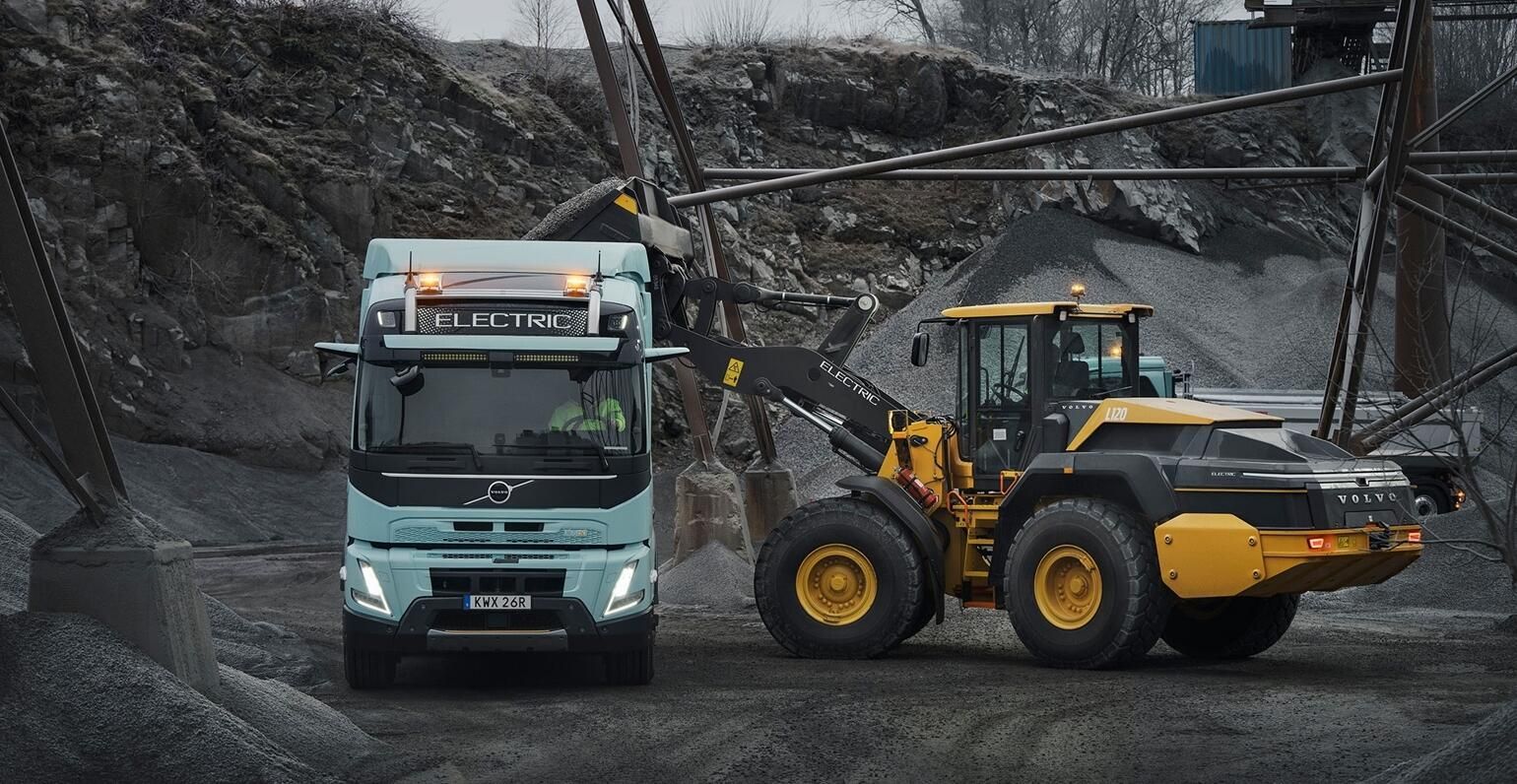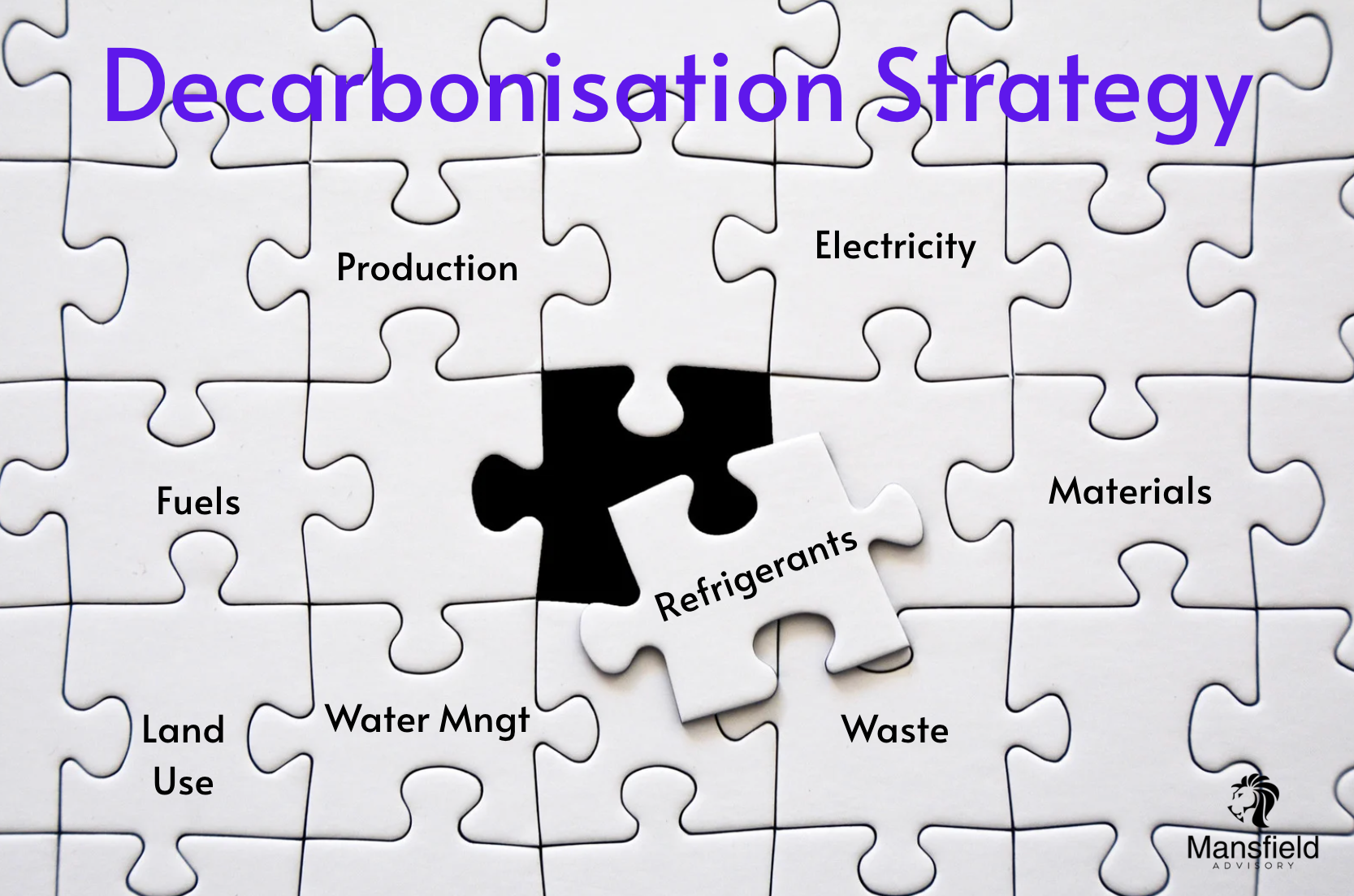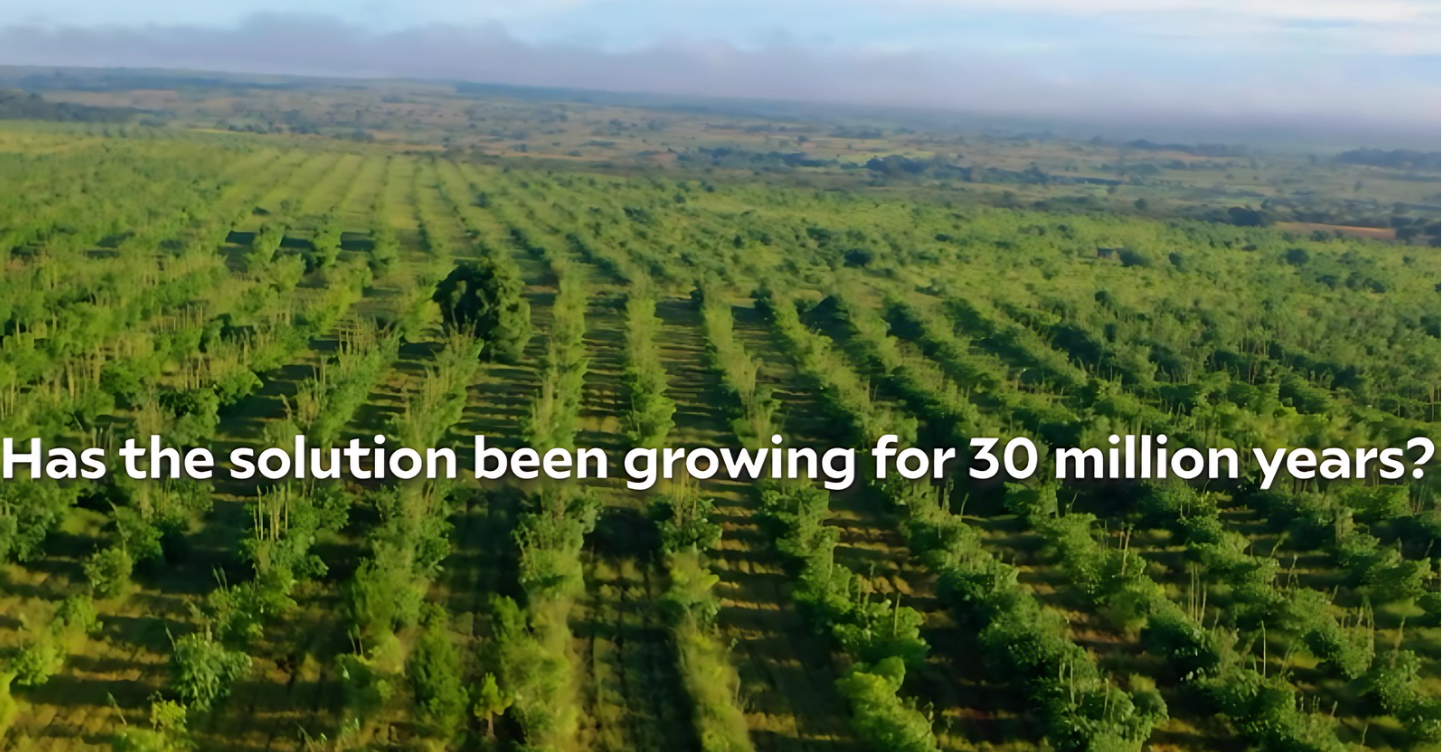Bamboo: Australia’s Untapped Ally for Sustainable Growth and Innovation
Mansfield Advisory Pty Ltd
200 followers
March 14, 2025
By Jeremy Mansfield OAM, Mansfield Advisory Pty Ltd
Is bamboo Australia’s next big economic opportunity? As a low-embodied carbon, bio-based material, bamboo complements timber’s role in sustainable forestry, offering rapid growth and versatile applications. Over 20 years, bamboo sequesters 167.5 tonnes of CO₂ equivalent per hectare (t CO₂e/ha)—197% more than timber’s 85 t CO₂e/ha—while delivering nearly $1.4 million from a $1 million investment compared to timber’s $738,189.20 [1, 2, 7–9]. Recent research [22] suggests bamboo could reduce global building emissions by substituting for high-carbon materials, unlocking massive potential. Why isn’t Australia scaling bamboo?
Bamboo’s Global Rise
Bamboo thrives globally. Asia, Africa, the Americas, and Europe tap its benefits, but Australia lacks a bamboo strategy. This country will miss out on a $67.13 billion market in 2024, which is set to grow to $88.44 billion by 2030 at a 4.7% CAGR [17]. China’s bamboo covers 5% of forest area and stored 129.7 TgC from 1987 to 2020 [18, 20].
Transition: With global momentum, Australia can boost sustainability and economies with bamboo.
Environmental Benefits: A Climate and Land Restoration Ally
Bamboo’s edge lies in its speed and management:
- Rapid Growth and Carbon Sequestration: Matures in 5 years, sequestering 252.5 t CO₂e/ha over 20 years at 15 t CO₂e/ha/year [1, 2]. Chilton et al. (2025) show that managed plantations accumulate 429 Mg C/ha—five times softwoods—while unmanaged ones halve this benefit [22, section on silvicultural management].
- Life Cycle Assessment (LCA) Flaws: Static LCAs and timber models undervalue bamboo’s rapid regrowth and soil carbon retention, treating it like slower softwoods and missing its environmental impact [22, section on carbon accounting flaws].
- Durable Products: Locks 70% of carbon into long-lived products, vs. timber’s 50% [3, 4].
- Soil Carbon and Restoration: Boosts soil carbon at 1 t CO₂e/ha/year, double timber’s 0.5 t CO₂e/ha/year [5, 6], and restores degraded lands.
- Biodiversity and Resilience: Clumping bamboo supports ecosystems and adapts to shifts.
These benefits position bamboo as a strategic asset for carbon reduction and land restoration—a powerful tool for meeting Australia’s net-zero emissions target by 2050.
These benefits position bamboo as a strategic asset for carbon reduction and land restoration—a powerful tool for meeting Australia’s net-zero emissions target by 2050.
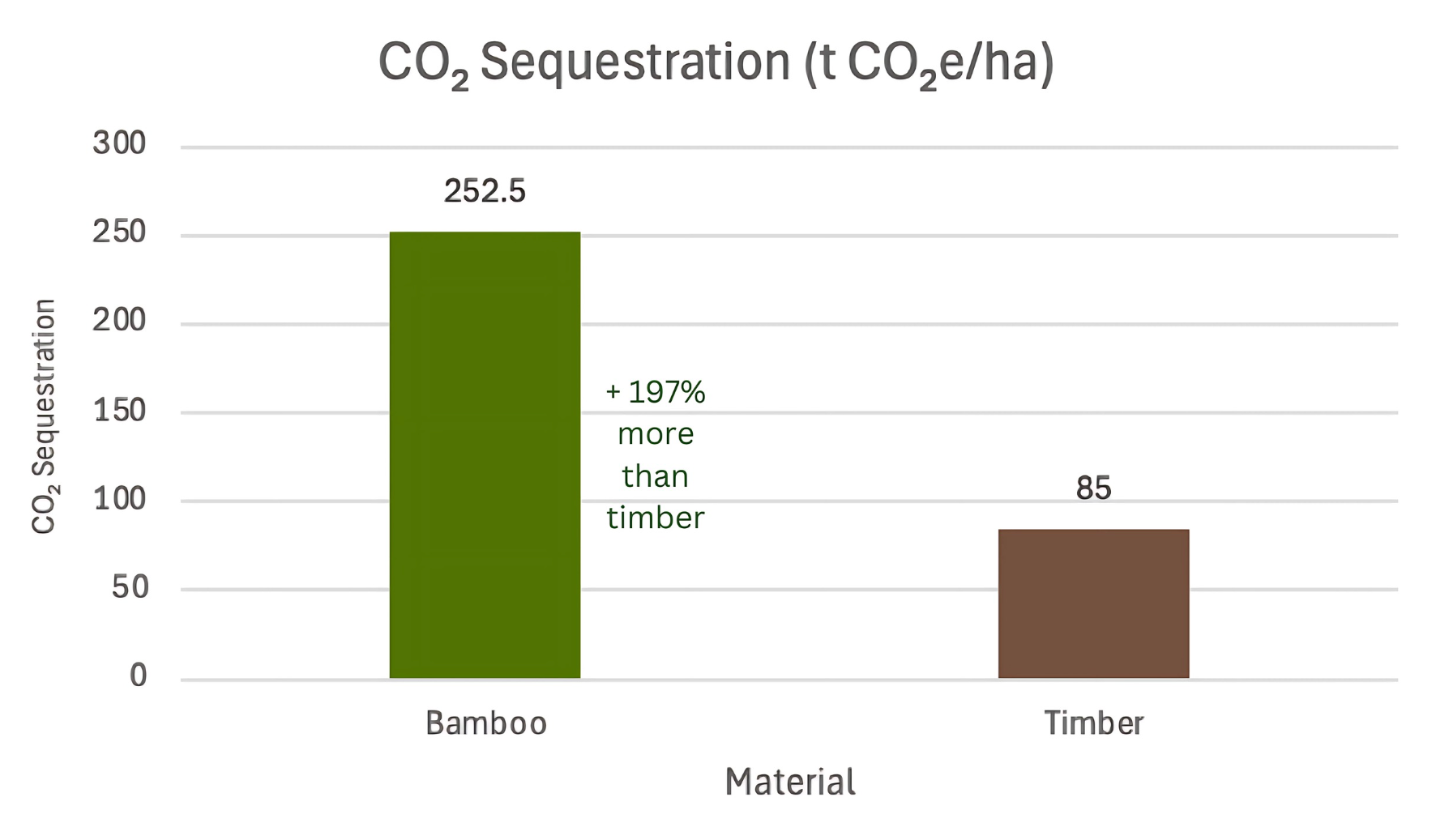
Carbon sequestration of bamboo and timber over 20 years. Bamboo's bar reaches 252.5 t CO₂e/ha, while timber's bar reaches 85 t CO₂e/ha [1, 2].
A recent analysis [22] concluded, on average, a hectare of timber bamboo can accumulate 429 Mg C ha−1 more than wood, nearly five times as much.” Timber bamboo’s superior carbon benefit from fast, early-growth, and annual partial harvesting is visibly evident”.
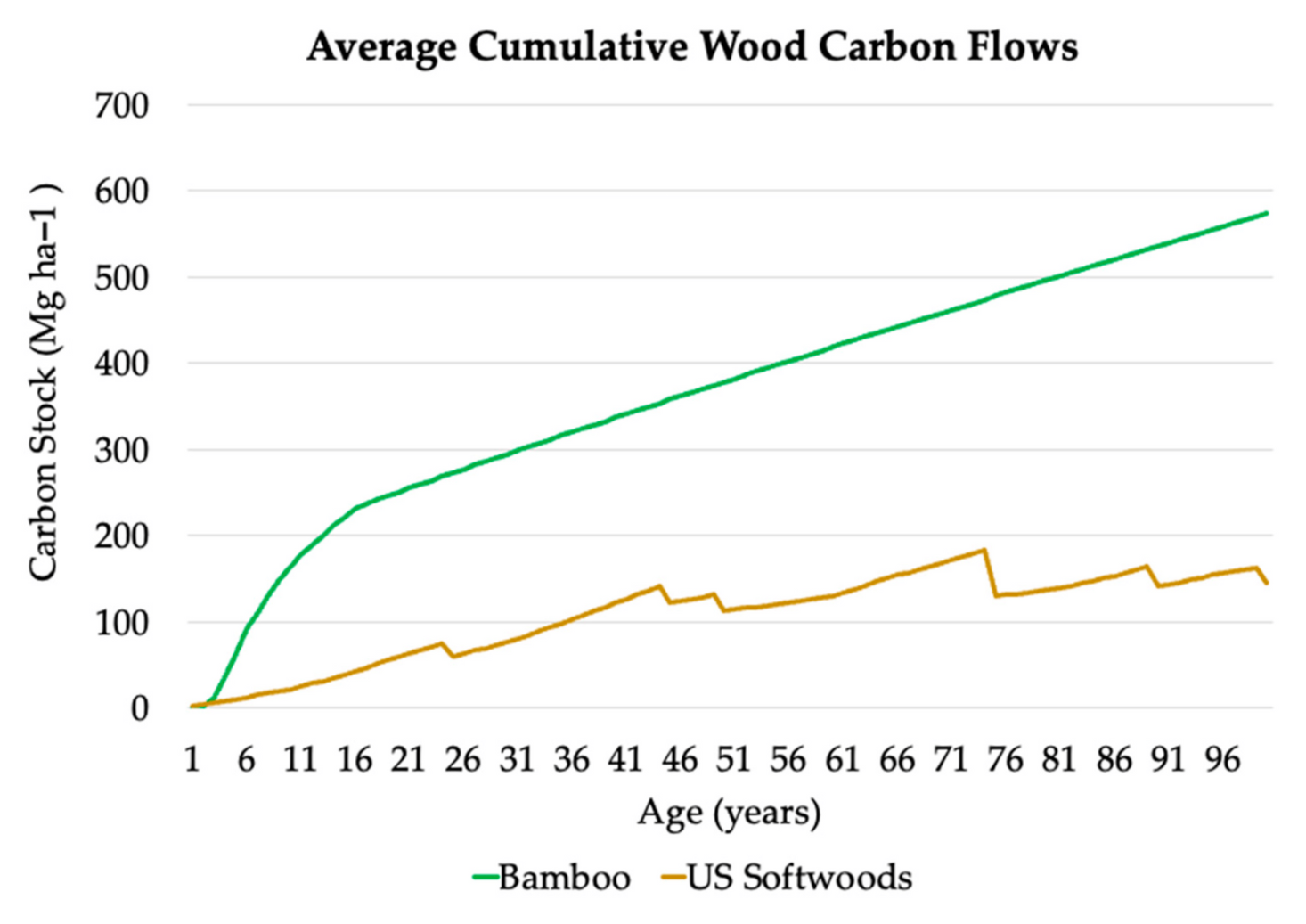
The average accumulation of net annual carbon flows, including plantation growth, harvest and harvested wood product (HWP) production, and final disposition of HWP, for numerous timber bamboo and US softwood species-location mixes. [Figure 7, 22]
Economic Benefits: Rapid Returns and Regional Growth
Bamboo delivers wins:
- Frequent Harvesting: A 5-year cycle yields 15 harvests in 20 years, compared to timber’s one harvest in 26–30 years, boosting jobs and activity.
- Financial Returns: A $1 million investment yields $1,386,250 vs. timber’s $738,189.20—1.9x the return. At $75/t CO₂e by 2035, returns soar [8, 9].
- Carbon Credits: Generates $9,090/ha over 20 years at $36/t CO₂e, vs. timber’s $3,060/ha [7].
Beyond Carbon: Bamboo’s Co-Benefits
Bamboo’s value extends further:
- Soil Restoration: Thrives on degraded lands like NSW Western Slopes [10].
- Biodiversity: Clumping bamboo supports ecosystems.
- Economic Growth: Creates jobs; potential impacts should be assessed.
- Resilience: Adapts to environmental variability.
Unlocking Bamboo’s Full Potential: Biochar and High-Value Construction Products
Structural Engineered Bamboo (SEB) and Laminated Bamboo Lumber (LBL) offer high tensile strength, durability, and flexibility, rivalling timber. Chilton et al. (2025) show Dendrocalamus asper outperforms softwoods, locking 70% of carbon into products vs. timber’s 50% [3, 4]. Waste becomes biochar, sequestering carbon [11], or fuels sustainable aviation fuel (SAF), renewable diesel, and graphene [12, 13] for advanced materials, broadening its impact on the circular economy and enhancing its investment appeal.
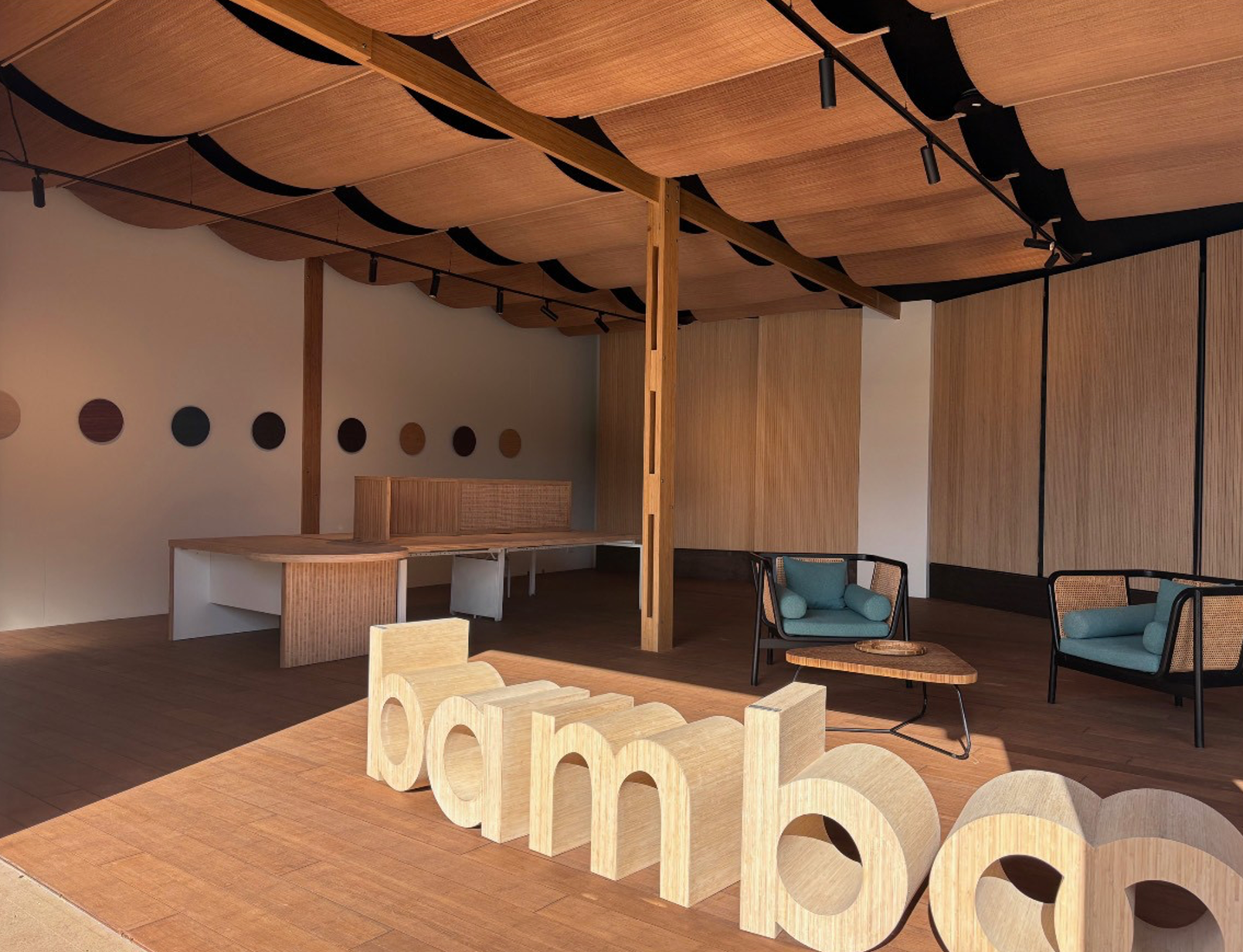
Source: House of Bamboo
Studies conducted by the University of Bath’s Dr. Bhavna, using common wood standards to allow comparison with engineered timber products, have shown that engineered bamboo boards and laminated bamboo have properties that compare with or surpass those of timber [21]. Results from testing of SEBs have found that:
- Mechanical properties are comparable to hardwoods.
- Exhibit compressive strengths greater than softwoods.
- Have tensile strengths greater than other wood species.
- They are more dimensionally stable in moisture and temperature changes when compared to timber based products (dependent on wood species).
Moreover, integrating bamboo with timber in composites leverages bamboo’s high strength and rapid renewability alongside timber's renowned workability and familiarity. This synergy results in materials that are not only durable but also highly sustainable, significantly reducing the embodied carbon footprint of construction materials, which contribute substantially to global carbon emissions.
As the demand for sustainable construction materials increases, these engineered bamboo products are poised to play a pivotal role in fulfilling global building requirements while minimizing environmental impact, increasing their demand and value.
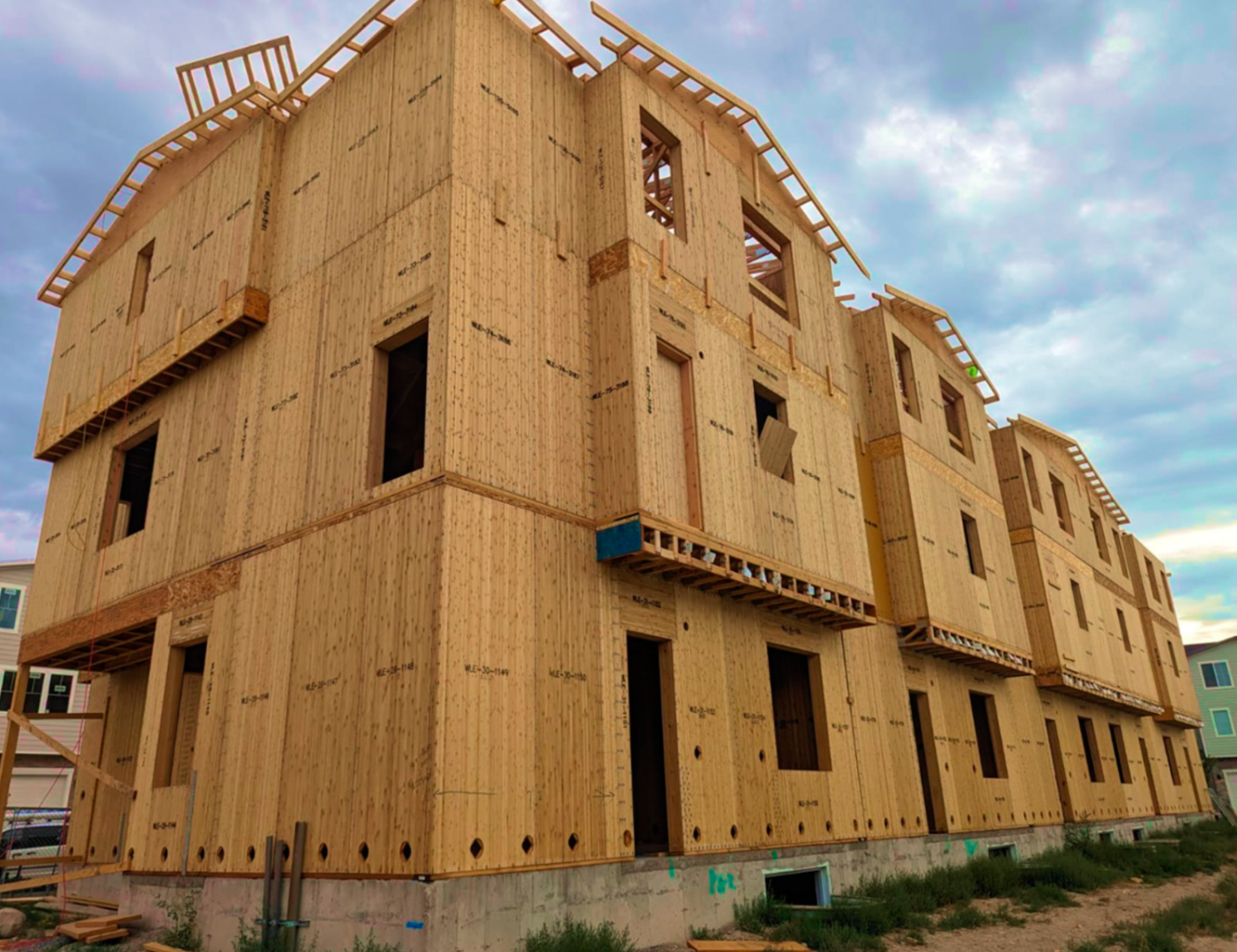
Six-unit town houses, comprising 3 stories on concrete slab with envelope framed from low-embodied carbon, high-thermal efficiency, off-site pre-fabricated bamboo–wood composite vertical framing (wall) system. Source: Figure 5 [22] International Building Code-compliant multifamily building in Salt Lake City, UT, USA
The Status Quo Challenge: Timber’s Entrenched Advantage
Overcoming barriers to bamboo adoption is critical:
- Grants favour existing systems, sidelining bamboo.
- Advocacy supports timber, overshadowing bamboo’s potential.
- Data on timber is robust, while bamboo lags.
- Recent ABARES data (2024) shows that Australia’s plantation estate shrank to 1.97 million hectares, signalling a supply crisis that bamboo could solve as a fast-growing complement, boosting sustainability and economies [23]. However, the carbon accounting flaws mentioned earlier hinder adoption [22, section on carbon accounting flaws]. A timber-focused framework overlooks bamboo’s potential. A collaborative ecosystem could integrate both, enhancing sustainability.
Despite these barriers, bamboo directly aligns with the Department of Agriculture and Forestry Support Plantation Establishment Program’s goals:
- Increasing Domestic Supply: Bamboo’s 5-year harvests can meet construction demand within a decade, with engineered products like SEB and Bamboo Scrimber matching hardwoods’ mechanical properties [3, 4].
- Reducing Emissions: Bamboo’s superior sequestration (252.5 t CO₂e/ha vs. 85 t CO₂e/ha) accelerates progress toward sustainability targets [1, 2].
- Current Exclusion: Yet, the program’s focus on softwood and hardwood plantations excludes bamboo, missing a chance for diversification.
To enrich Australia's forestry sector, we must evolve policies to embrace bio-based materials like bamboo. This shift would acknowledge bamboo’s rapid growth and carbon storage, enhancing timber by providing complementary resources. Integrating bamboo creates a resilient, diverse ecosystem, supporting sustainable development without undermining timber and unlocking economic and environmental gains.
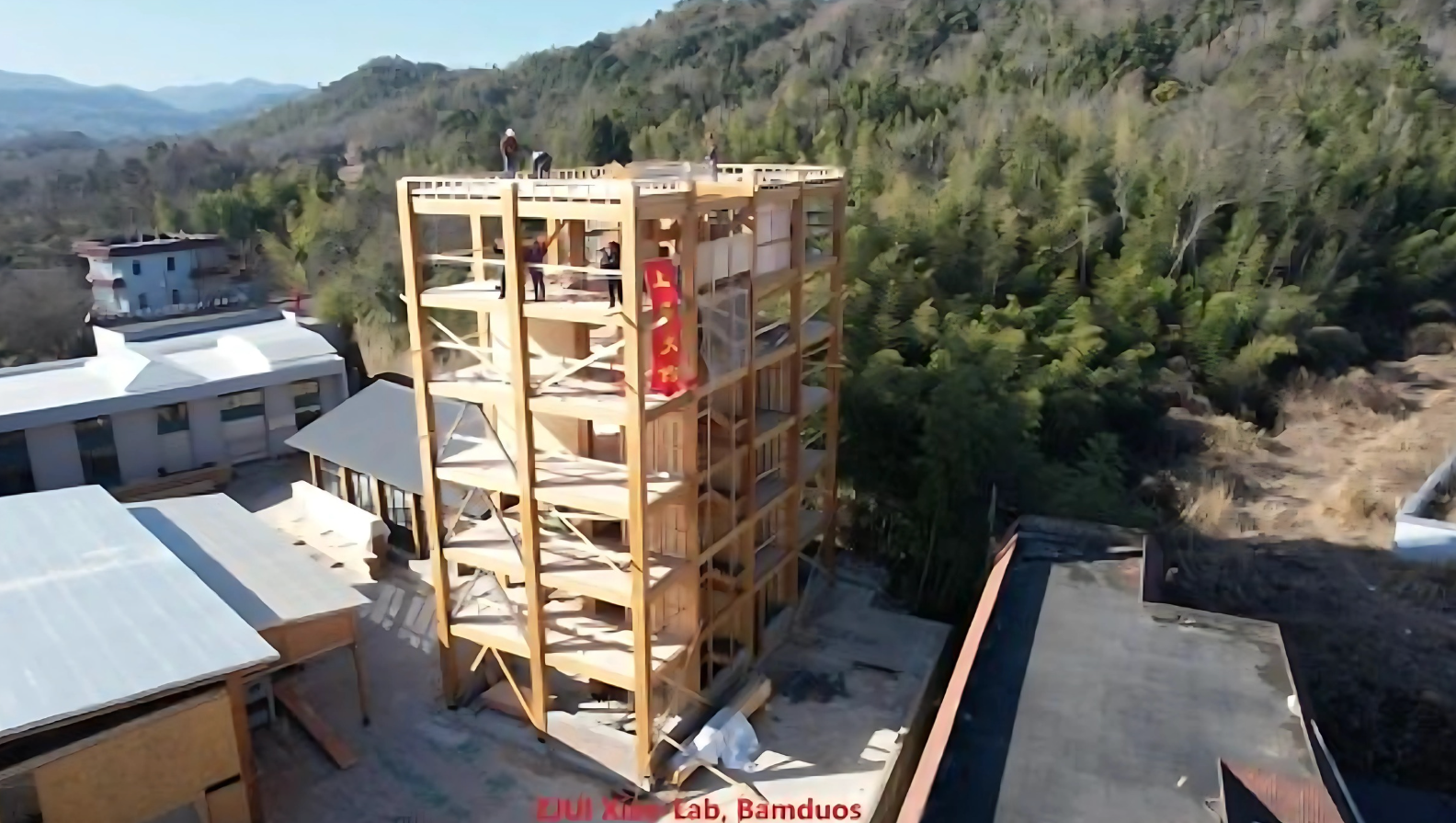
World's First and Tallest Structural Engineered Bamboo Building, a 21-metre, 6-story bamboo structure. Source: Zhejiang University-University of Illinois Urbana-Champaign Institute [25]
Australia: A Bamboo Opportunity
Australia, the only continent without a bamboo strategy, could lead:
- Degraded Lands: Bamboo can restore poor soils.
- Sustainability Goals: It supports net zero by 2050.
- Economic Potential: A bamboo industry could boost rural economies, and impacts should be assessed.
Potential Locations for Bamboo Plantations
According to recent research, several promising regions across Australia have been identified for potential bamboo cultivation:
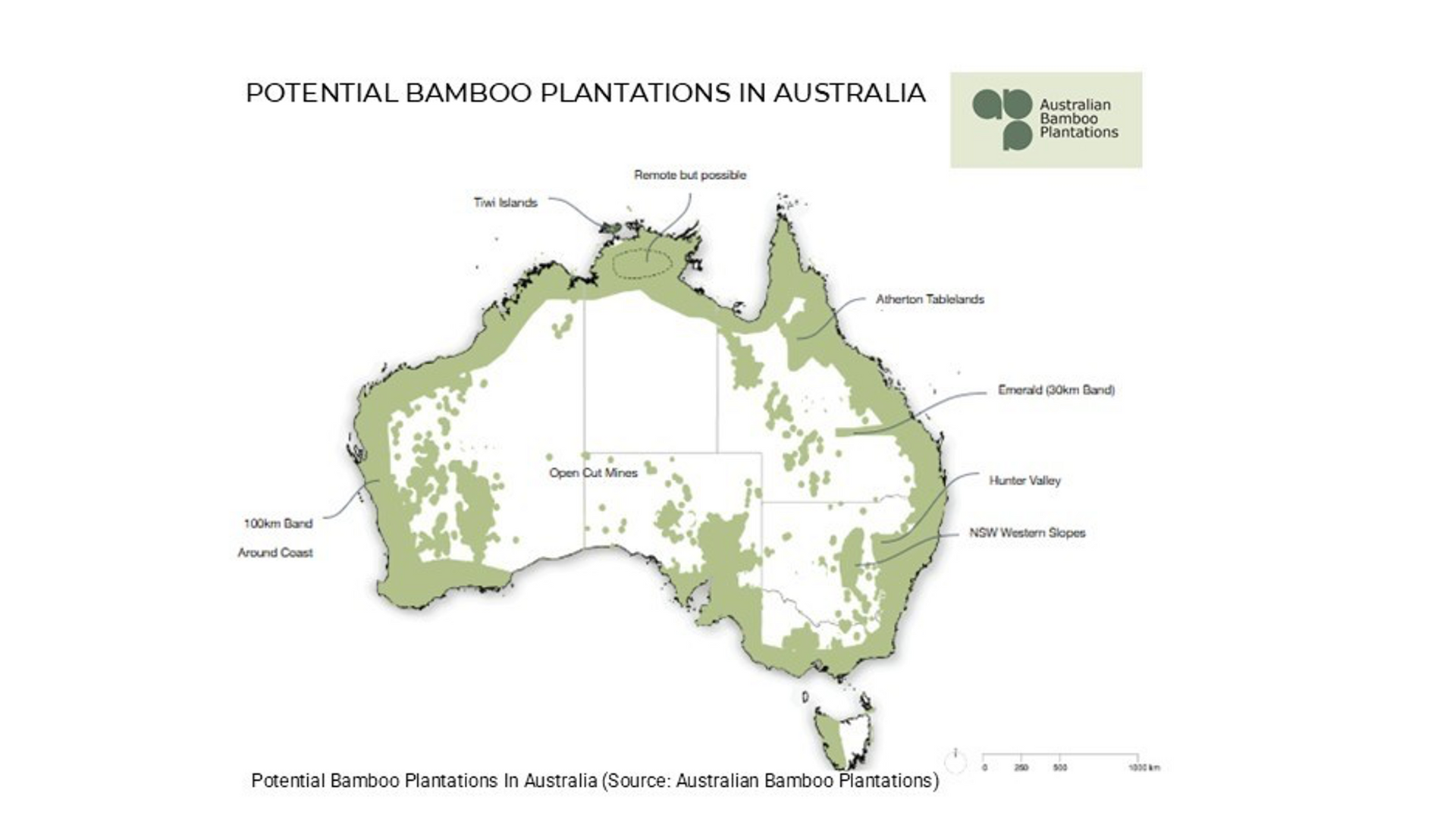
Source: Australian Bamboo Plantations
Harvesting Timing: Bamboo vs. Timber
Given the focus on the next 20 years, hardwood species, like eucalypts, typically require around 80 years to reach maturity for optimal carbon sequestration and structural use and are less relevant for our analysis. Instead, we'll compare bamboo to softwood like pine, which offers a more immediate comparison within our timeframe:
- Bamboo: After an initial growth period of 5 years, when the poles have matured enough for use in structural engineered bamboo, selective harvesting can begin. From year 5 onwards, bamboo can be harvested annually by selectively cutting the ready poles, allowing for 15 additional harvest cycles within our 20-year analysis. Over this period, bamboo sequesters 252.5 t CO₂e/ha. This frequent harvesting enhances its environmental benefits and significantly stimulates continuous economic activity, providing a sustainable boost to regional economies through regular job creation and income streams.
- Timber (Pine): While pine might not reach full maturity until around 26–30 years, for our comparison, within 20 years, pine sequesters approximately 85 t CO₂e/ha. Pine's full potential would be realized over a more extended period, but our analysis focuses on the growth up to 20 years [6, 14].
The Call to Action: Bamboo Should Complement Timber
Let’s unite—government, investors, landowners, designers, and builders—to unlock bamboo’s potential:
- Debunk Myths: Educate on native bamboo and dispel myths to build trust and attract investment [1].
- Shift Focus: Advocate bamboo in grants and markets, valuing its 197% environmental benefits for sustainability [7, 8].
- Invest: Scale plantations for 1.9x returns, driving jobs and growth - potential economic and social impacts should be assessed [7].
- Launch a Bamboo 2045 Vision: A 20-year plan to lead globally, supporting sustainability targets [7].
- Support R&D: Innovate harvesting tech for competitiveness, per Chilton et al. (2025), to enhance efficiency and scalability in Australia [7, 22].
- Update Carbon and Forestry Metrics: Ensure LCAs and carbon forestry accounting reflect bamboo’s rapid regrowth and soil carbon retention, addressing flaws noted by Chilton et al. (2025), to drive adoption [22, section on carbon accounting flaws].
- Join INBAR: Become an INBAR member to access global expertise, positioning Australia as a bamboo leader [1].
- Collaborative Policy: Expand regulations to complement timber, share incentives for mutual growth, and fund R&D.
Join this movement—comment below on how you can help!
Bamboo offers a compelling alternative to timber, delivering 197% more environmental benefits per hectare and nearly double the return on investment. With its vast degraded lands and native clumping bamboo species, could Australia be on the cusp of a sustainable transformation? In our next article, we’ll dive into the potential of non-native clumping bamboo species and explore how to introduce them responsibly, drawing on biosecurity lessons from other timber species. What do you think—could bamboo be Australia’s next big opportunity? Share your thoughts below!
References
- International Bamboo and Rattan Organization (INBAR). (2021). Bamboo as a Tool for Climate Change Mitigation and Adaptation. Beijing, China: INBAR. Retrieved from https://www.inbar.int/resources/
- Nath, A. J., Lal, R., & Das, A. K. (2015). Managing woody bamboos for carbon farming and carbon trading. Global Ecology and Conservation, 3, 654–663. https://doi.org/10.1016/j.gecco.2015.03.002
- Van der Lugt, P., Vogtländer, J., & Brezet, H. (2018). Bamboo for Climate Change Mitigation: Carbon Sequestration and Product Innovation. INBAR Technical Report No. 37. Beijing, China: International Bamboo and Rattan Organization. Retrieved from https://www.inbar.int/resources/
- Intergovernmental Panel on Climate Change (IPCC). (2019). 2019 Refinement to the 2006 IPCC Guidelines for National Greenhouse Gas Inventories. Calvo Buendia, E., Tanabe, K., Kranjc, A., et al. (Eds.). Switzerland: IPCC. Retrieved from https://www.ipcc-nggip.iges.or.jp/public/2019rf/
- Yuen, J. Q., Fung, T., & Ziegler, A. D. (2017). Carbon stocks in bamboo ecosystems worldwide: Estimates and uncertainties. Forest Ecology and Management, 393, 113–138. https://doi.org/10.1016/j.foreco.2017.01.017
- Intergovernmental Panel on Climate Change (IPCC). (2006). 2006 IPCC Guidelines for National Greenhouse Gas Inventories. Eggleston, H. S., Buendia, L., Miwa, K., Ngara, T., & Tanabe, K. (Eds.). Hayama, Japan: Institute for Global Environmental Strategies (IGES). Retrieved from https://www.ipcc-nggip.iges.or.jp/public/2006gl/
- Clean Energy Regulator (CER). (2024). Quarterly Carbon Market Report: Q2 2024. Canberra, Australia: Australian Government. Retrieved from http://www.cleanenergyregulator.gov.au/
- NSW Treasury. (2021). Technical Note on Carbon Pricing. Sydney, Australia: NSW Government. Retrieved from https://www.treasury.nsw.gov.au/
- EY. (2023). Australia’s Carbon Market Outlook 2023. Sydney, Australia: EY Net Zero Centre. Retrieved from https://www.ey.com/au/netzero
- Parr, J. F., Sullivan, L. A., & Quirk, R. G. (2010). Sugarcane phytoliths: Encapsulation and sequestration of long-lived carbon fractions. Soil Biology and Biochemistry, 42(11), 1931–1938. https://doi.org/10.1016/j.soilbio.2010.07.013
- Lehmann, J., & Joseph, S. (Eds.). (2015). Biochar for Environmental Management: Science, Technology and Implementation (2nd ed.). London, UK: Routledge. https://doi.org/10.4324/9780203762264
- U.S. Department of Energy (DOE). (2020). Sustainable Aviation Fuel: Review of Technical Pathways. Washington, DC: U.S. Department of Energy. Retrieved from https://www.energy.gov/sites/prod/files/2020/09/f78/beto-sust-aviation-fuel-sep-2020.pdf
- Li, Y., Zhang, H., Wu, B., & Guo, Z. (2019). Graphene from bamboo charcoal: Synthesis, characterization, and applications. Carbon, 149, 234–241. https://doi.org/10.1016/j.carbon.2019.04.014
- Food and Agriculture Organization of the United Nations (FAO). (2020). Global Forest Resources Assessment 2020: Main Report. Rome, Italy: FAO. Retrieved from https://www.fao.org/documents/card/en/c/ca9825en
- Sedjo, R. A., & Sohngen, B. (2012). Carbon sequestration in forests and soils. Annual Review of Resource Economics, 4(1), 127–144. https://doi.org/10.1146/annurev-resource-083110-115941
- Escamilla, E. Z., & Habert, G. (2014). Environmental impacts of bamboo-based construction materials. Construction and Building Materials, 101, 51–60. https://doi.org/10.1016/j.conbuildmat.2014.10.058
- Grand View Research. (2024). Bamboo Market Size, Share & Trends Analysis Report By Product (Timber, Pulp & Paper), By Application (Furniture, Construction, Textile, Paper & Pulp, Agriculture, Energy), By Region, And Segment Forecasts, 2023 - 2030. San Francisco, CA: Grand View Research, Inc. Retrieved from https://www.grandviewresearch.com/industry-analysis/bamboo-market
- State Forestry and Grassland Administration of China. (2021). China Forestry Statistical Yearbook 2020. Beijing, China: China Forestry Publishing House. Retrieved from http://www.forestry.gov.cn/main/65/20210323/141230880856430.html
- INBAR. (2020). Bamboo for Climate Change Mitigation: A Global Review. Beijing, China: International Bamboo and Rattan Organization. Retrieved from https://www.inbar.int/resources/
- Song, X., et al. (2021). Carbon storage in bamboo ecosystems: A review of current knowledge and future research directions. Forest Ecology and Management, 495, 119371. https://doi.org/10.1016/j.foreco.2021.119371
- Sullivan, C.C, Sustainable Envelopes with Structural Engineered Bamboo: (SEB) Engineered Bamboo Products deliver structural, and renewable, bio-based solutions for high-performance building enclosure systems.( 2021) Retrieved from Renutaq.com https://www.renuteq.com/_files/ugd/df390b_acad093a68194dbc8f3c3a010ee9018c.pdf
- Chilton, K.; Kadivar, M.; Hinkle, H. (2025). From Problems to Possibilities: Overcoming Commercialization Challenges to Scale Timber Bamboo in Buildings. Sustainability, 17, 1575. https://doi.org/10.3390/su17041575
- ABARES. (2024). Australian Plantation Statistics Update 2022–23. Canberra, Australia: Australian Government. Retrieved from https://www.agriculture.gov.au/abares/forest-australia/australian-plantation-statistics
- Clean Energy Regulator. (2024). Carbon Credits (Carbon Farming Initiative) (Audit Thresholds) Amendment (Low Risk Plantation Forestry Projects) Instrument 2024. Canberra, Australia: Australian Government. Retrieved from https://www.cer.gov.au/publications/carbon-credits-carbon-farming-initiative-audit-thresholds-amendment-low-risk-plantation
- Zhejiang University. (2024). World’s First 6-Story Engineered Bamboo Building Unveiled. Hangzhou. Retrieved from https://www.zju.edu.cn/english/2024/0130/c19573a2876560/page.psp
First published on LinkedIn 14th March 2025
